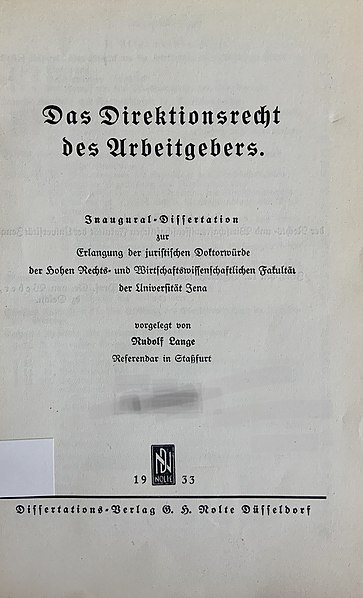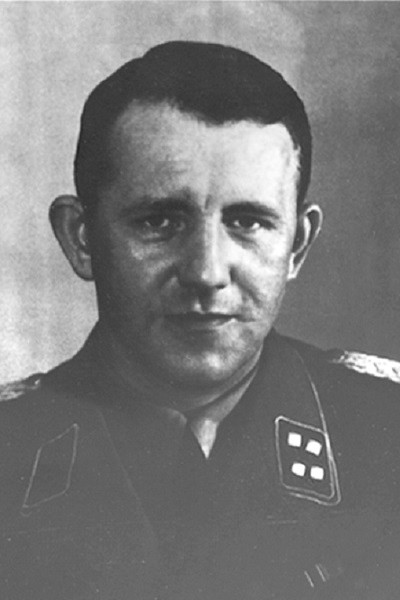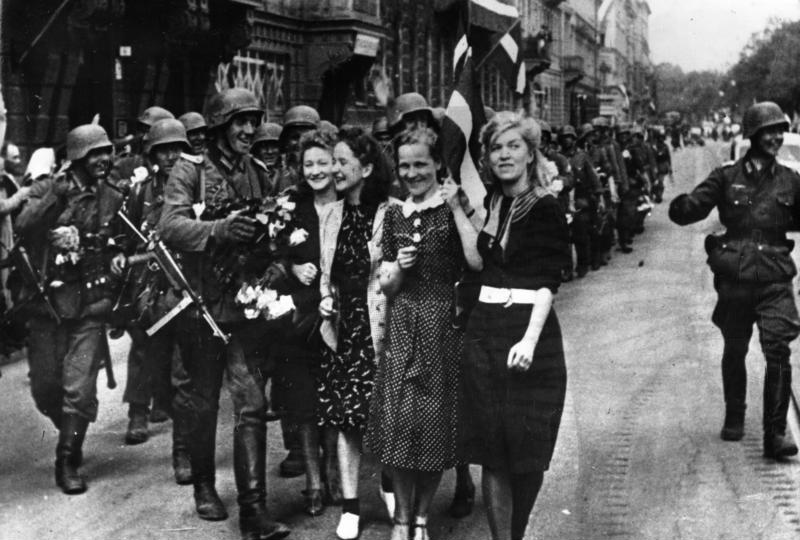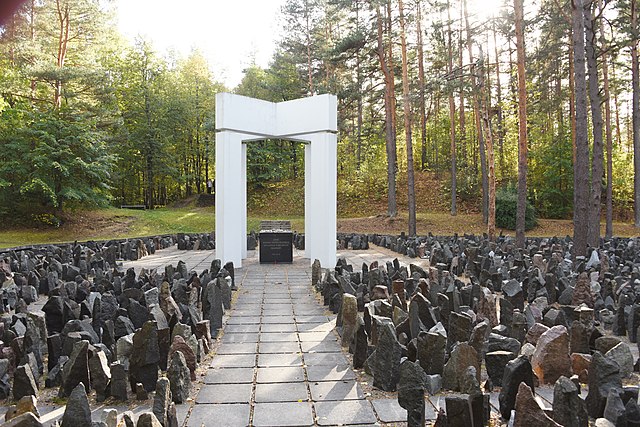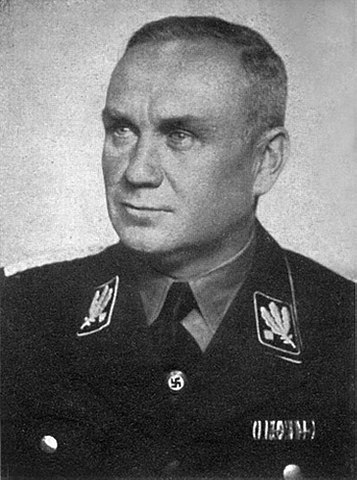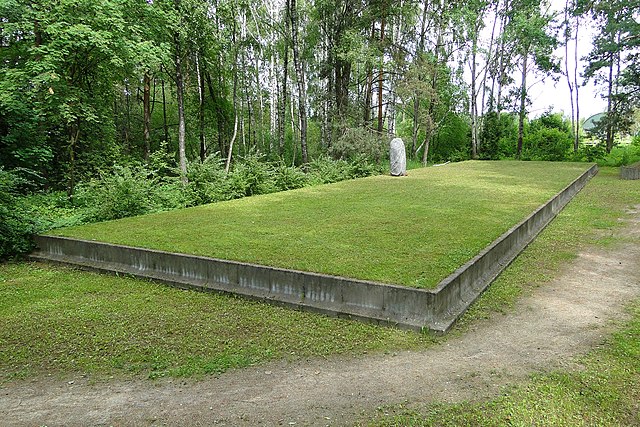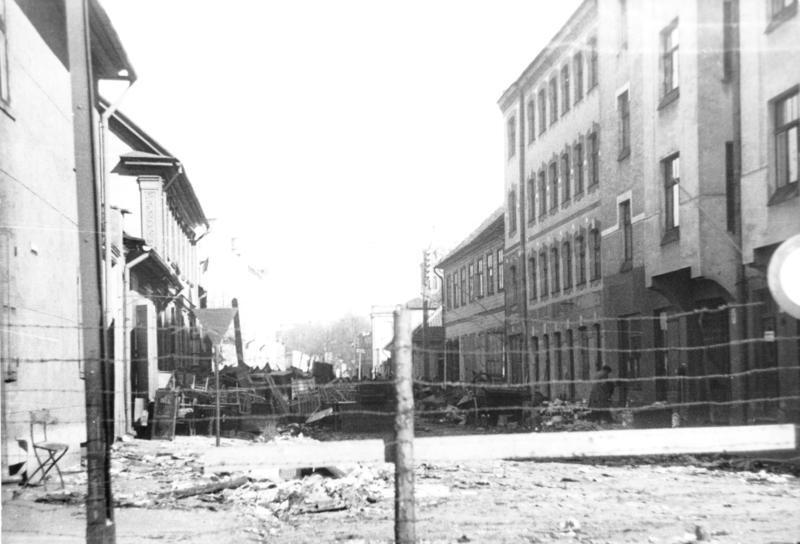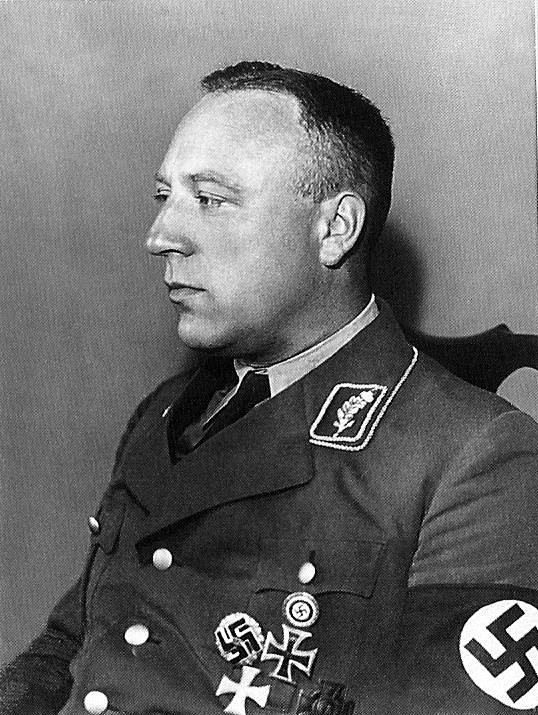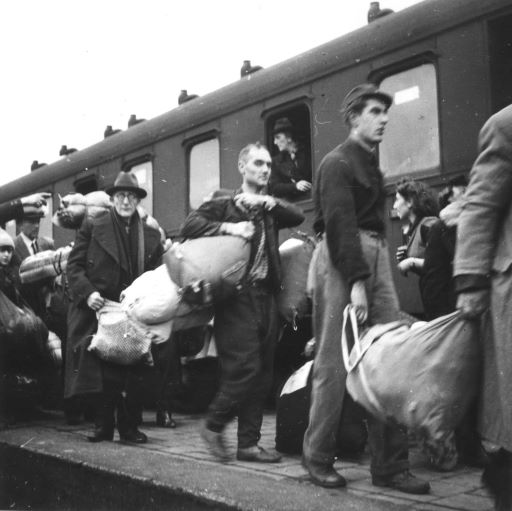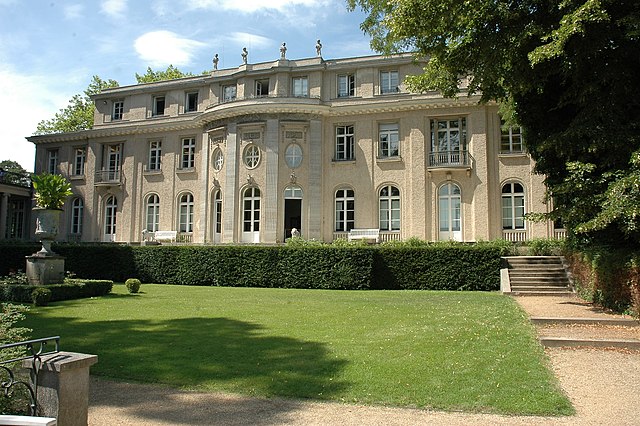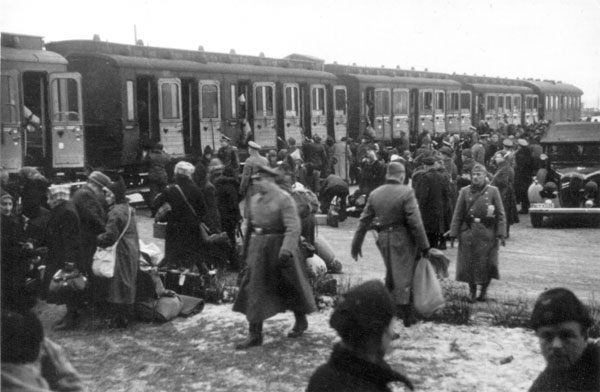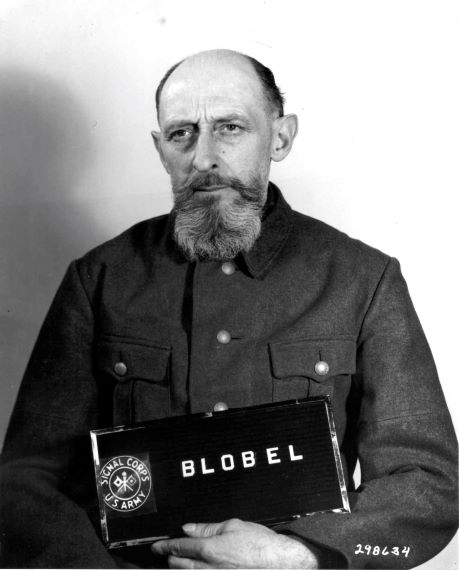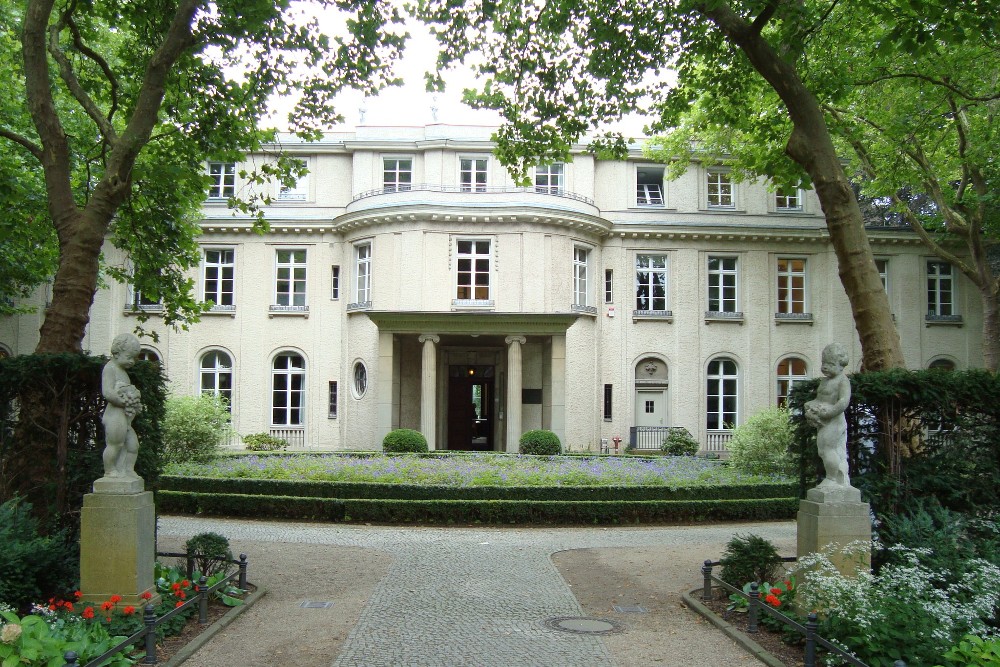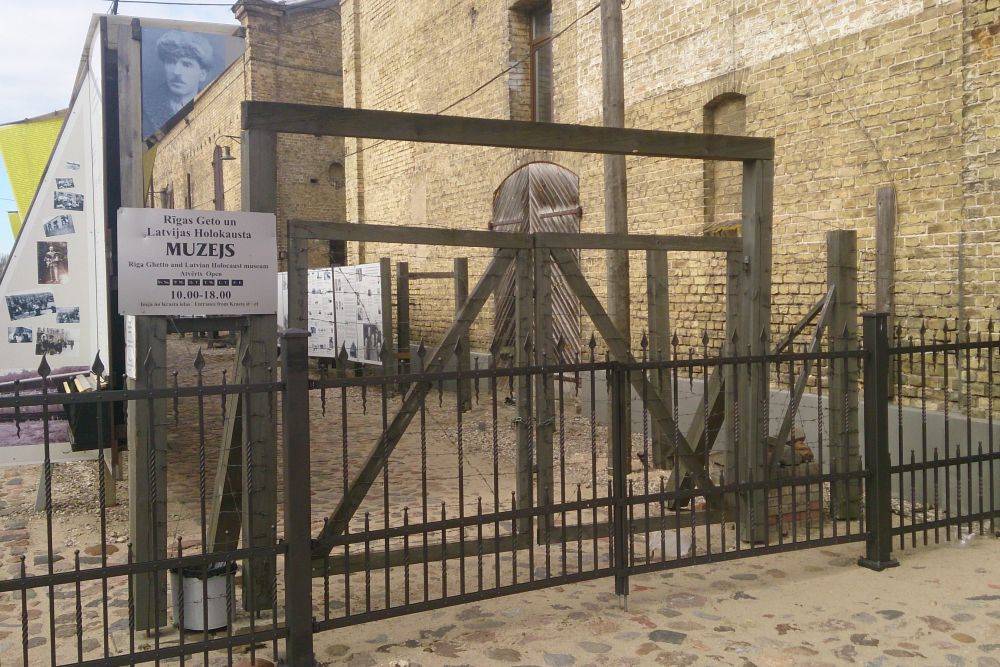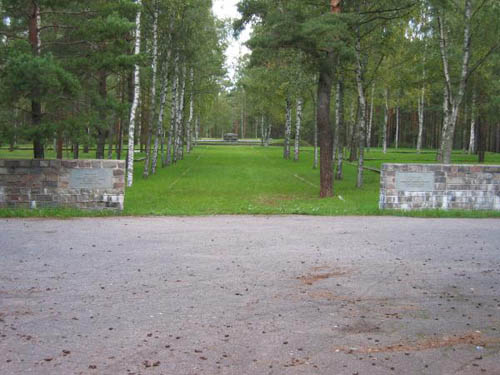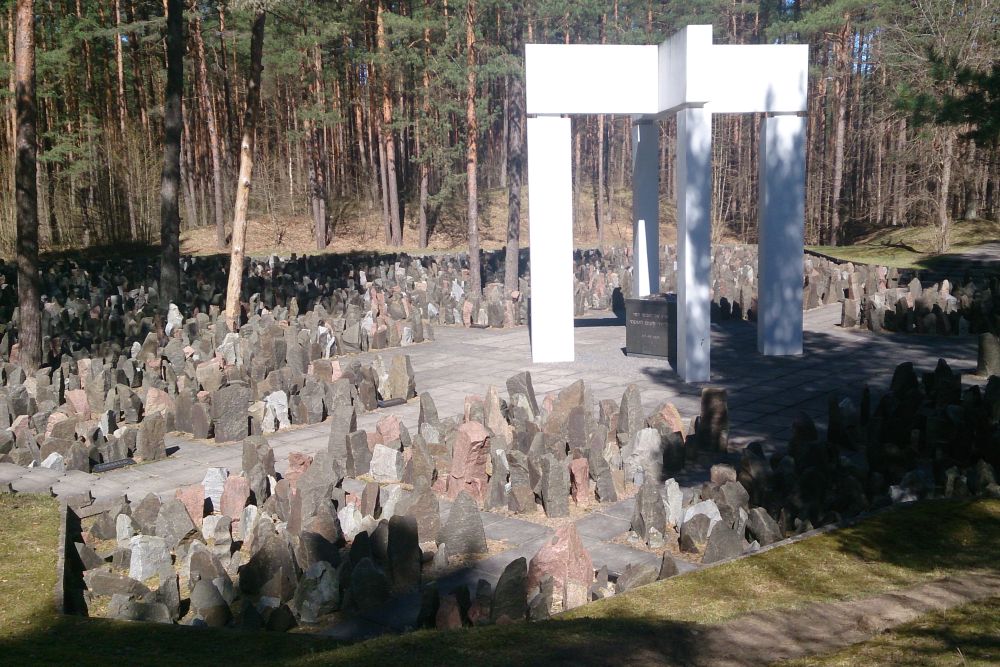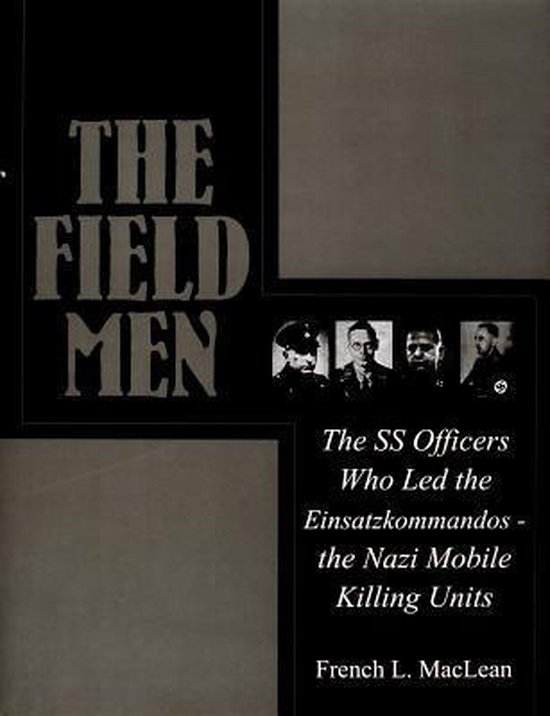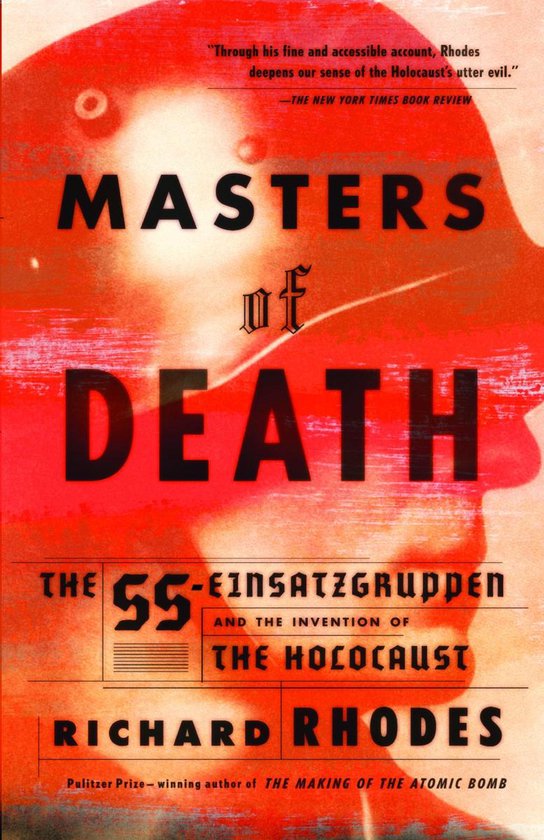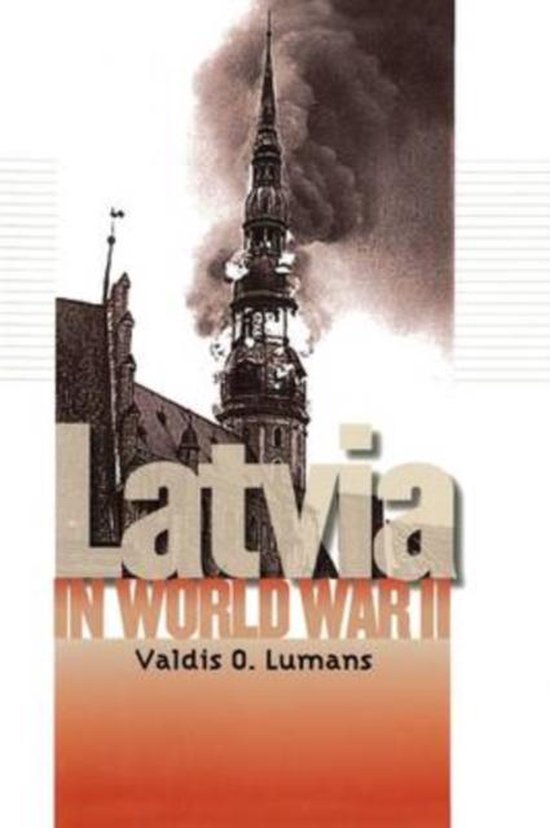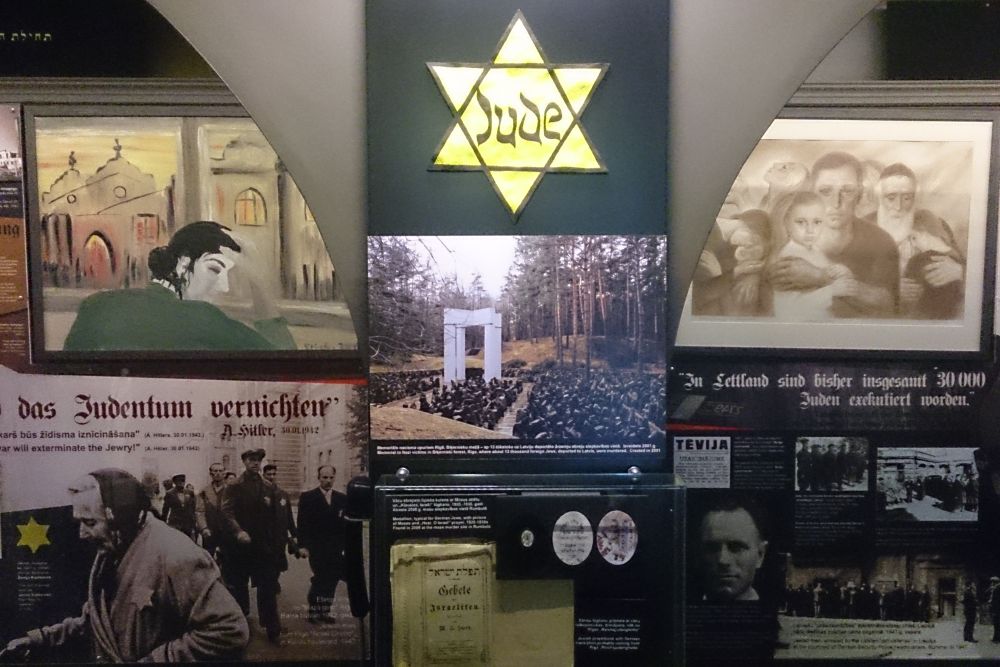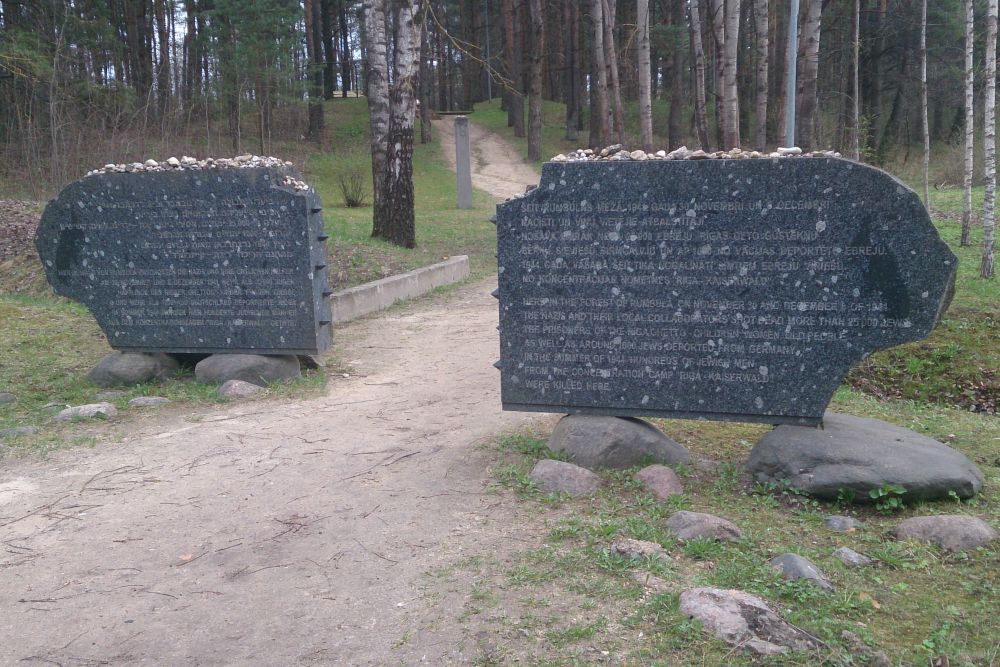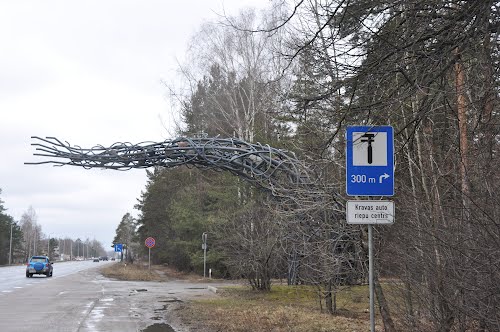Early years
Martin Franz Erwin Rudolf Lange was born April 18, 1910 in Weißwasser in Prussian Silesia, located in the extreme northeast of current Saxony on the German-Polish border. He was the son of August Lange, building inspector of the Reichsbahn and his wife Margarethe Laugksch. Due to the work of the father, the family rehomed several times. The result was that Lange jr. attended primary school in Treptow a.d. Tollensee (today Altentreptow in the northeast of the currrent Federal Republic) between 1916 and 1919 and secondary school in Staßfurt, south of Magdeburg in current Saxony-Anhalt.
After final exams, Lange studied law at the universities of Jena, Munich and Halle. In Jena, he was a member of the nationalistic and anti-Semite student union Germania and that left marks on his face: scars of fencing duels. Following his graduation in July 1932, Lange was employed by the courts in Staßfurt, Magdeburg, Torgau and Naumburg as a lawyer. Between August 20 and September 29, he did voluntary labor in Gartz am Oder. On December 12, 1933, he promoted to doctor at law at the university of Jena on a thesis entitled Das Direktionsrecht des Arbeitsgebers (The righs of the employer). In the same year he entered service in the Gestapo in Halle and in November, he joined the SA.
Career in the Gestapo
That was the start of a career in the Gestapo which would last for years. Being a medium level police officer, he was tasked with fighting opponents of the regime (Gegnerbekämpfung). Lange and his hundreds of colleagues saw to the continuous and smooth operation of the Nazi terror apparatus. From August 1936, he served in the Gestapo in Berlin and subsequently in Halle again. His SA membership did his career no good and therefore, he changed course within the Nazi organization. On October 11, 1936, he joined the SS (number 290,308) in the rank of SS-Sturmmann and on November 15, 1937, he became a member of the NSDAP (number 4,922,869). He now fully embraced the SS- ideology and cancelled his membership of the Lutheranian Church.
Now, Lange's career rocketed, not disturbed by even the smallest blemish on his record. After the annexation of Austria on March 13, 1938 - the so-called Anschluß, the services of this model Gestapo officer were badly needed in the new part of the Reich. In May 1938, he was transferred to Gestapo HQ in Vienna and soon after, on July 6, he was promoted to SS-Untersturmführer. In Vienna, Lange supervised the incorporation of the Austrian police force into the German system of law enforcement. On the executive level, he played a major role in his capacity of chief of Abteilung II B in the isolation and persecution of the Viennese Jews. The head of the Jewish community in Vienna, Joseph Löwenherz, soon had to deal with him. On July 1938, Lange summoned him to his office for talks with municipal officials. Lange came down to business right away, announcing a plan to treat Jewish patients in hospitals separately because 'Aryan' nurses couldn't be expected to treat Jewish patients. Lange ordered Löwenherz to prepare for this separation immediately.
In Vienna, Lange cooperated closely with Franz Walter Stahlecker, Inspekteur der Sicherheitspolizei und des SD in Austria. A few years later these men would cross their paths again. On November 9, Lange was promoted to SS-Obersturmführer.
In June 1939, Lange became deputy chief of the regional Gestapo HQ in Stuttgart and his promotion to SS-Hauptsturmführer followed on April 20, 1940. From May to July 1940, he headed the Gestapo offices in Weimar and Erfurt and at the same time, he was deputy chief of the office of the Inspekteur der Sicherheitspolizei und des SD in Kassel. A transfer to Berlin followed on September 17, 1940. In the capital. he was deputy chief of Gestapo HQ, located in the main police office on Alexanderplatz. On May 1, 1941 he was promoted to SS-Sturmbannführer.
Lange's employment by the Gestapo in Germany ended June 5, 1941 when he was ordered to report to the Grenzpolizeischule Pretzsch/Elbe. In the castle of Pretzsch, a village southwest of Berlin near Wittenberg in current Saxony-Anhalt, members of the Einsatzgruppen were being prepared for their deployment in the East from May 1941 onwards. Following the German invasion of the Soviet Union on June 22, 1941, four Einsatzgruppen der Sicherheitspolizei und des SD, designated A, B, C, and D were deployed behind the front. An important task of these units was the extermination of local Jewish communities.
Definitielijst
- Abteilung
- Usually part of a Regiment and consisting of several companies. The smallest unit that could operate independently and maintain itself. In theory an Abteilung comprised 500-1,000 men.
- Gestapo
- “Geheime Staatspolizei”. Secret state police, the secret police in the Third Reich.
- ideology
- A collection of principles and ideas of a certain system.
- invasion
- Armed incursion.
- Jews
- Middle Eastern people with own religion that lived in Palestine. They distinguished themselves by their strong monotheism and the strict observance of the Law and tradition. During World War 2 the Jewish people were ruthlessly persecuted and annihilated by the German Nazis. . An estimated 6,000,000 Jews were exterminated.
- Nazi
- Abbreviation of a national socialist.
- Soviet Union
- Soviet Russia, alternative name for the USSR.
Deployment in Latvia
Rudolph Lange was posted as chief of staff to Einsatzgruppe A, commanded by SS-Brigadeführer und Generalmajor der Polizei Walter Stahlecker, an acquaintance from his time in Vienna. The unit numbered some 1,000 men, making it the largest of the four. After the invasionof the Soviet Union, the unit followed Heeresgruppe Nord of the Wehrmacht advancing northeast in the direction of Leningrad. The operational area encompassed the Baltic states of Estonia, Latvia and Lithuania.
He arrived in Latvia right after the quick capture of the capital of Riga from the Red Army. Initially, he was in command of a so-called Teilkommmando of Einsatzkommando 2 (EK2), part of Einsatzgruppe A which was deployed a little further behind the front and mainly active in Latvia. The goal of EK2 was as simple as horrendous: carrying out mass executions behind the front. In Lange's words: 'Right from the start, the goal of EK2 was the radical solution of the Jewish problem by murdering all Jews'.
He swung into action. Right after his arrival in Latvia he issued orders by telephone to Latvian auxiliary police units, established by the Germans, to commence mass executions. The so-called Kommando Arãjs, commanded by the former Latvian police officer Viktor Arãjs who had offered his services to Stahlecker after the occupation, was notorious. The Kommando expanded steadily and was formally designated Lettische Hilfspolizei der Sicherheitspolizei und des SD. (Latvian auxiliary police ……) It operated like a mobile murder squad of Einsatzgruppe A and was placed under direct command of Lange by Stahlecker.
Definitielijst
- Heeresgruppe
- The largest German ground formation and was directly subordinate to the OKH. Mainly consisting of a number of “Armeen” with few directly subordinate other units. A Heeresgruppe operated in a large area and could number several 100,000 men.
- Jews
- Middle Eastern people with own religion that lived in Palestine. They distinguished themselves by their strong monotheism and the strict observance of the Law and tradition. During World War 2 the Jewish people were ruthlessly persecuted and annihilated by the German Nazis. . An estimated 6,000,000 Jews were exterminated.
- Red Army
- Army of the Soviet Union.
- Soviet Union
- Soviet Russia, alternative name for the USSR.
- Wehrmacht
- German armed military forces, divided in ground forces, air force and navy.
Start of the mass murders
The victims of the first mass executions of EK2 were usually Jewish males but in many locations across the entire country, soon entire families were murdered. The Latvian auxiliary police - transported from Riga in blue Swedish-made busses - acted in part independently and in part in cooperation with the Einsatzgruppe. During the 'actions of the blue busses' everywhere in the Latvian countryside Jewish inhabitants were herded to the outskirts of their towns and villages and transported to nearby forests to be executed. They were buried in large pits, dug by themselves or by local farmers forced to do so.
On July 4, 1941, synagogues in Riga were set on fire by Arãjs' men. Thereafter, random pick-ups, house searches, kidnappings and murder were the order of the day in town. Each night, Kommando Arãjs dragged groups of Jews from prisons in town, established by the SIPO and Arãjs. They were transported by truck to the Bikernieki forest east of Riga in order to be killed. Lange supervised these executions personally. Orders to that end were usually issued by him. He would have ordered all SD officers to take part in the executions personally. Lange himself attended the first executions in the forest. An estimated 4,000 people were murdered there.
Another Latvian murder squad receiving orders from Lange was the so-called Vagulāns Kommando, commanded by the fanatic Latvian anti-Semite Mārtiņš Vagulāns. This unit, together with German police forces of Einsatzgruppe A participated at the end of July and early August 1941 in the extermination of nearly the entire population of the provincial town of Jelgava, some 28 miles south of Riga. Vagulāns was the local chief of police. The exact number of victims is unknown but estimates vary between 1,500 and 2,000. The Germans erected signs on the roads leading into town with the text: Jelgava ist Judenrein (Jelgava is free of Jews).
In October 1941, the elimination of Jews in the smaller Latvian towns and villages was completed. Of the local Jewish communities, hardly anyone was still alive. Between July and October 1941, some 34,000 Jews in all of Latvia were killed by Einsatzgruppe A and Latvian auxiliary units commanded by Lange.
Definitielijst
- Jews
- Middle Eastern people with own religion that lived in Palestine. They distinguished themselves by their strong monotheism and the strict observance of the Law and tradition. During World War 2 the Jewish people were ruthlessly persecuted and annihilated by the German Nazis. . An estimated 6,000,000 Jews were exterminated.
- SIPO
- ”Sicherheitspolizei”. Combination (since 1936) of the Gestapo and criminal police.
The Rumbula mass murder
On September 17, 1941 Adolf Hitler decided that Jews from the Great German Empire, Austria and the annexed parts of Czechoslovakia were to be deported to the East. On October 31, 1941 the Judenreferat of the Reichssicherheitshauptamt (RSHA), headed by Adolf Eichmann, issued directives for the deportation of these so-called Reichsjuden to the Reichskommissariat Ostland, encompassing the entire Baltic area and parts of Belorussia. The choice of these regions was obvious: the Einsatzgruppen were already busy exterminating Jewish communities. SS-Obergruppenführer Reinhard Heydrich, chief of the RSHA had marked Minsk in Belorussia and Riga as final destination for the trains.
The initial destination for the first trains was Minsk but as the local ghetto was soon overcrowded, the trains were diverted to Riga because of ‘transport problems’. Beginning at the end of November 1941, the first deportations trains rolled from the German Empire towards Riga. The problem facing the Germans was that the ghetto in the meantime, established a short while before, was already overcrowded with 29,000 Latvian Jews. There was simply no room for the deportees from Germany. A 'solution' wasn't long in coming. Reichsführer-SS Heinrich Himmler simply ordered his representative in Latvia, Höherer SS- und Polizeiführer (HSSPF) Russland-Nord und Ostland and Führer der SS-Oberabschnitts Ostland SS-Obergruppenführer Friedrich Jeckeln, 'Platz zu schaffen' (make room) in the ghetto in Riga. This meant the liquidation of the inhabitants. In November, Rudolph Lange was closely involved in the organization and execution of this mass murder. He was the commander of one of the murder squads.
The location of the mass murder of these Latvian Jews was a small pine forest, selected by Jeckeln himself, near the small railway station of Rumbula, 7,5 miles south of Riga. An advantage of this location was the sandy ground, making the digging of mass graves easy. On November 1941, known as 'Riga bloody Sunday', some 15,000 Latvian Jews were marched from the ghetto to the forest in the freezing cold and through the snow. Males and females were separated. In icy temperatures - it was the coldest winter of the century until then - they were to undress and hand over their valuable possessions. Subsequently they were forced to lie face down and alternately, close together in pits, 32 to 45 feet deep dug by Soviet Pows. They were shot with machinegun fire in the back of the head by German police, SS units of Einsatzgruppe A and by Latvian auxiliary police including Kommando Arãjs.
When one layer in the pit was full, the next group of victims was to lie face down on top of the bodies and a new round of executions followed. The perpetrators acted in shifts of five or six who were relieved every 90 minutes. This system, devised by Jeckeln himself was called Sardinenpackung after the efficient way of packing sardines in a tin.
In that early morning of November 30, the first victims were 1,053 men, women and children though. They had been deported three days before from Berlin on the first transport and - contrary to planning - had arrived in Riga November 29. Jeckeln was unpleasantly surprised by the arrival of this transport which he couldn't find any accommodation for. There had not yet been made room in the ghetto for these Jews and an intended camp in nearby Salaspils wasn't ready yet. For Jeckeln, the solution was obvious: liquidation. For this mass execution - which 50 young men would survive - he was severely reprimanded by Himmler who had issued the order shortly before that these German Jews were not to be killed. The SS chief wanted to deploy these Jews as forced laborers right behind the front line. After a telephone call with Heydrich, Himmler had noted: 'Judentransport aus Berlin. Keine Liquidierung' (Jewish transport from Berlin: No liquidation). Jeckeln's action on his own initiative was not tolerated. In contrast to Jeckeln, Lange showed his insight into the power balance within the higher SS echelons: his men arrived in Rumbula only after the Berlin Jews had been murdered. Ignoring an order from the highest SS chief and the RSHA was unwise to say the least.
December 8 and 9, the murders in Rumbula continued. Commanded by Lange, who had meanwhile been appointed commander of Einsatzgruppe 2, German and Latvian murder squads killed another 12,500 Jews taken from the ghetto in Riga. Only a handful of people survived the Jeckeln Aktion. Lange informed to Berlin that in Riga everything was ready to receive Jews from the Reich.
Of the four Einsatzgruppen deployed behind the Eastern front, Einsatzgruppe A murdered the majority of the people in the period until the end of 1941. In December, commander Stahlecker reported to Berlin that in the entire operational area in the Baltic, 249,420 Jews had been killed. Lange's EK 2 accounted for some 60,000 Latvian Jews and Jews deported to Latvia. He was largely responsible for the extermination of almost the entire Jewish population of the country.
Definitielijst
- Führer
- German word for leader. During his reign of power Adolf Hitler was Führer of Nazi Germany.
- ghetto
- Part of a town separated from the outside world to segregate Jewish population. The establishment of ghettos was intended to exclude the Jews from daily life and from the rest of the people. From these ghettos it was also easier to deport the Jews to the concentration and extermination camps. Also known as “Judenviertel” or Jewish quarter.
- Jews
- Middle Eastern people with own religion that lived in Palestine. They distinguished themselves by their strong monotheism and the strict observance of the Law and tradition. During World War 2 the Jewish people were ruthlessly persecuted and annihilated by the German Nazis. . An estimated 6,000,000 Jews were exterminated.
- RSHA
- Reichssicherheitshauptamt. The central information and security service of the Third Reich.
SD chief in Latvia
In December 1941, Lange wasn't in command of EK2 only; that month he was also appointed Kommandeur der Sicherheitspolizei und des SD (KdS) in Latvia. His boss was Walter Stahlecker in his capacity of Befehlshaber der Sicherheitspolizei und des SD for the Reichskommissariat Ostland. Lange directed the SD organization in Latvia from its HQ on Reimersastraße in Riga via local branches in the most important cities in the country. In this position, Lange became the prime perpetrator of the organization and execution of the mass murder of the European Jews in Latvia. Jeckeln and Stahlecker - they paid ever more attention to the fighting at the front and Partizanenbekämpfung (fighting partisans) - totally relied on Lange. The SD chief acted as Jeckeln's prime hangman.
After the arrival of the first Jews from Germany on November 29 - who had been liquidated on orders of Jeckeln the next day in the Rumbula forest due to a shortage of space in the ghetto - from December 3 onwards, the trains carrying Reichsjuden continued to arrive at the shunting yard of Skirotava on the south side of Riga. Although nearly all Latvian inhabitants of the ghetto had been murdered in Rumbula, the next 4 transports carrying a total of 3,984 Reichsjuden from Nuremberg, Stuttgart, Vienna and Hamburg were housed in the freezing cold and in horrible conditions in a temporary camp just outside Riga. The oldest were two 84-year-old women and the youngest four infants not yet a year old. This camp, called Jungfernhof and established by order of Lange, was located on the grounds of an abandoned and decrepit estate which had been rented by the SS from the German civil administration. Until March 1942, it served as a transit camp for Jews deported from Germany and Austria.
On December 10, the sixth deportation train from the Reich arrived in Riga, carrying Jews from Cologne. They were the first to be taken straight to the ghetto without having stayed in another location first. Their luggage was confiscated immediately by the Gestapo and they were marched to the ghetto, in the freezing cold and guarded by the SS; their only possessions being the clothes on their backs. Food wasn't distributed, they would have to find some themselves in the part of the ghetto allocated to them.
Generalkommissar Otto-Heinrich Drechsler, responsible for the German civil administration in Latvia, was far from happy with the growing influx into the ghetto. He sent an angry memo to Lange, protesting against the transfer of these Jews to the ghetto. As it happened, his men were still busy searching the homes of the Latvian Jews murdered in Rumbula for jewelry, money and furs left behind. To that end, he had closed complete city blocks to the Reichsjuden to enable his men to search them thoroughly first. Drechsler's protest made no impact whatsoever on Lange. In Rumbula, the SD chief had shown his sense of power and orders from the RSHA carried more weight than the protests of a civil administrator. This would not have hurt Lange's reputation in Berlin at all.
Despite Drechsler's protest, Lange continued filling the ghetto. Until early February 1942, another 14 trains carrying over 15,000 Reichsjuden from Kassel, Düsseldorf, Münster, Osnabrück, Bielefeld, Hannover, Theresienstadt, Vienna, Berlin, Leipzig, Dresden and Dortmund followed. Lange personally supervised the arrivals in Riga, supported by his right-hand man, SS-Obersturmführer Gerhard Maywald. 'Production levels ' had to be met and speed was essential: on arrival of a transport, Lange personally shot a young man who, in his opinion, did not open the door of a train door quickly enough.
Definitielijst
- ghetto
- Part of a town separated from the outside world to segregate Jewish population. The establishment of ghettos was intended to exclude the Jews from daily life and from the rest of the people. From these ghettos it was also easier to deport the Jews to the concentration and extermination camps. Also known as “Judenviertel” or Jewish quarter.
- Jews
- Middle Eastern people with own religion that lived in Palestine. They distinguished themselves by their strong monotheism and the strict observance of the Law and tradition. During World War 2 the Jewish people were ruthlessly persecuted and annihilated by the German Nazis. . An estimated 6,000,000 Jews were exterminated.
- RSHA
- Reichssicherheitshauptamt. The central information and security service of the Third Reich.
- Theresienstadt
- City in the Czech Republic. Here the Nazis established a model concentration camp.
Kurtenhof
In Latvia, not only Jews were among Lange's victims. As early as October 1941, he had ordered Maywald to establish a Polizeigefängnis und Arbeitserziehungslager, police prison/labor camp for mainly political prisoners in a forest, 12 miles southeast of Riga near Salaspils on the river Düna. The camp was also known as Lager Kurtenhof after a nearby estate. It was initially built some miles from the Rumbula forest and Jungfernhof by Soviet PoWs and Czech Jews deported from Theresienstadt. At the end of December 1941, some 1,000 Reichsjuden - mainly transferred from the ghetto in Riga – worked under horrendous conditions on the expansion of the camp. Again in mid-February 1942, some 500 male Reichsjuden were taken from the ghetto in Riga to work on the construction; in May , the last 300 or so laborers followed. They were selected for their profession, age and physical fitness and they really had to work themselves to death. In June 1942, a dozen or so of them returned to the ghetto as 'living skeletons'. Most of them died shortly afterwards.
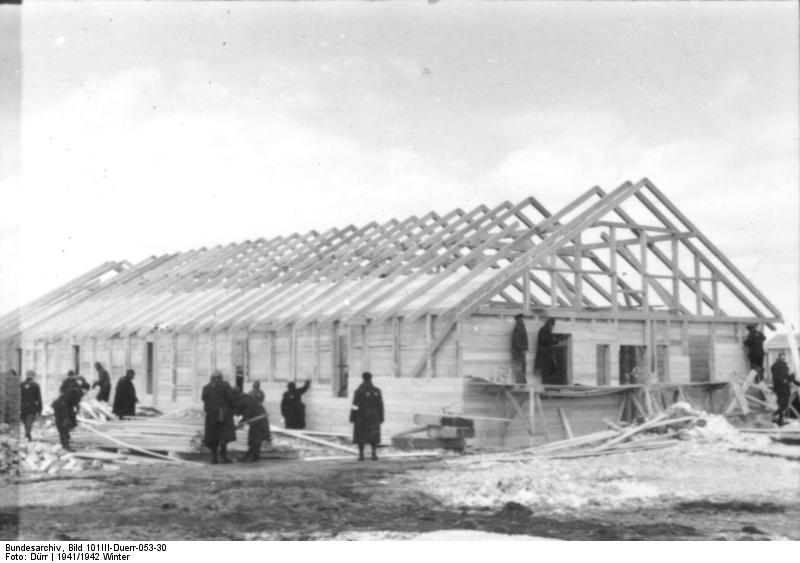
Jewish prisoners at a building site of a barracks in Camp Kurtenhof, December 22, 1941. Source: Bundesarchiv, Bild 101III-Duerr-053-30 / Dürr / CC-BY-SA 3.0
Kurtenhof's first commander was SS-Oberscharführer Richard Nickel who had been Lange's driver in Berlin for a while. SD chief Lange had exclusive authority over the camp and Nickel reported to him daily. The smallest violation of the camp rules led to penal executions, usually attended by Lange hinself. He also used the camp as the location for the execution of inhabitants of the Riga ghetto. He carried out executions himself as well: he had the inmates kneel in front of him and subsequently shot them through the head.
In Kurtenhof, mainly political prisoners were interned who had to do hard forced labor in and outside the camp. The mortality rate was high due to exhaustion, execution, lack of food, poor sanitary facilities, diseases and insufficient housing. A slogan circulated among the inmates: 'Lange will's, viele Opfer fordert Salaspils' (Lange wants it, Salaspils claims many victims).
While in January 1942 Lange actively made his contribution to the extermination of the European Jews, he was invited to take part in a conference in Berlin. The subject of the meeting must not have sounded strange to him.
Definitielijst
- ghetto
- Part of a town separated from the outside world to segregate Jewish population. The establishment of ghettos was intended to exclude the Jews from daily life and from the rest of the people. From these ghettos it was also easier to deport the Jews to the concentration and extermination camps. Also known as “Judenviertel” or Jewish quarter.
- Jews
- Middle Eastern people with own religion that lived in Palestine. They distinguished themselves by their strong monotheism and the strict observance of the Law and tradition. During World War 2 the Jewish people were ruthlessly persecuted and annihilated by the German Nazis. . An estimated 6,000,000 Jews were exterminated.
- mid
- Military intelligence service.
- Theresienstadt
- City in the Czech Republic. Here the Nazis established a model concentration camp.
The Wannsee Conference
On January 20, 1942, a conference was held in a villa at Am Großen Wannsee 56/58 in Berlin with the aim to organize and coordinate the Endlösung der Judenfrage (final solution of the Jewish question). The conference didn't order the mass murder of the European Jews – this decision had in fact already been taken by the mass murders of the Einsatzgruppen - in the German occupied areas in the East following the invasion of the Soviet Union on June 22, 1942 – but the organization and coordination of the deportation and extermination of the entire Jewish population was on the agenda. German historian Peter Longerich typified the conference pointedly – in railway terms – as the correct setting of switches: the how, when and where of the Endlösung was fine-tuned again between the various state and party organs.
The meeting had been called by Reinhard Heydrich in his capacity as chief of the SIPO and SD. It was chaired by him and it was attended by 14 high-ranking NSDAP and SS functionaries and top officials of various ministries. Lange represented his boss Walter Stahlecker. He was the last to be invited and had to hurry and fly from Riga to Berlin. In the minutes (see Wannsee protocol) his name is at the bottom of the list. At 31 years of age, he was the youngest of the attendants and had the lowest SS rank. His authority was therefore less than that of the high-ranking representatives of the NSDAP and other officials.
Among historians there is a difference of opinion as to why Lange was invited by Heydrich. The most common view is that Lange - next to Karl Eberhard Schöngarth, SD chief in the Generalgovernment – was qualified by experience. In the second half of 1941, he had played a key role in the mass executions of Jews in the Baltic region and in the meantime, he had 'processed' 14 transports of Reichsjuden to Riga. His personal participation in the mass murders and his experience with deportations from the Reich, could have been considered additional value by Heydrich. Lange could have given the attendants a first-hand report on the reality and the feasibility of the physical extermination. Although elsewhere in the region, Jews had been killed in their masses ordered by local SD chiefs, Lange's 'station' Riga was the most important destination of the deportation trains. His boss Stahlecker was stationed elsewhere and was also unfamiliar with the reality and daily practice of the deportations. Moreover and despite the protests of the civil administration, Lange had carried out Heydrich's orders to the letter. Finally, Heydrich would have preferred Lange because of his having graduated as a lawyer. His contribution would therefore have carried more weight.
Peter Longerich however doubts the argument of 'qualified by experience'. He sees it as utter speculation that Lange has actually spoken during the meeting about the murders in the region for which he was responsible. The minutes contain no reference whatsoever to Lange's contribution. Moreover, it would have violated Heydrich's conference strategy not to dig too deeply into the horrific details of the reality of the Endlösung. Adolf Eichmann however testified during his trial in 1961 that the various methods of murder had actually been discussed but – assuming this is correct – it isn't known whether he referred to Lange's contribution.
The attendants to the conference parted after they had set the chronological sequence of the next mass murders. They agreed on working at the Endlösung together, directed by the RSHA.
Definitielijst
- Endlösung
- Euphemistic term for the final solution the Nazis had in store for the “Jewish problem”. Eventually the Endlösung would get the form of annihilating the entire Jewish people in extermination camps.
- invasion
- Armed incursion.
- Jews
- Middle Eastern people with own religion that lived in Palestine. They distinguished themselves by their strong monotheism and the strict observance of the Law and tradition. During World War 2 the Jewish people were ruthlessly persecuted and annihilated by the German Nazis. . An estimated 6,000,000 Jews were exterminated.
- RSHA
- Reichssicherheitshauptamt. The central information and security service of the Third Reich.
- SIPO
- ”Sicherheitspolizei”. Combination (since 1936) of the Gestapo and criminal police.
- Soviet Union
- Soviet Russia, alternative name for the USSR.
- strategy
- Art of warfare, the way in which war should be conducted in general.
Back in Latvia, the murdering continues
During Lange's short absence and after his return to Riga, the deportation trains continued to come in. On February 10, 1942, 20 transports carrying a total of 20,057 Reichsjuden arrived in Riga of which some 15,000 were still alive. Lange probably has 'made a contribution' to this mortality rate. Allegedly he would have been in charge of a mass execution of deported Berlin Jews on January 30, 1942. There also is a case of the liquidation of a transport of Jews from Vienna led by him. This isn't certain as sources contain insufficient evidence.
It is certain though that Lange did play a leading role in the so-called Aktion Dünamünde which was carried out in two parts. In March 1942, the overpopulation of the ghetto in Riga reached alarming proportions. Therefore it was decided to liquidate Reichsjuden unfit for forced labor such as the elderly, the disabled, the sick and mothers with young children. They were made to believe they would be performing light work under far better living conditions in a - non-existent – canned fish factory in Dünamünde (in Latvian Daugavgrīva) in a suburb in northwestern Riga. Lange's right-hand man Gerhard Maywald had concocted this lie. Lured by a better existence outside the ghetto some 1,900 people too weak or unfit for heavy work, reported. On March 15 or 16 – sources are not sure of the date - they were taken by truck to the Bikernieki forest and executed by members of the Kommando Arājs. They were buried in large pits which were dug previously.
Hereafter, the second part of Aktion Dünamünde unfolded. Camp Jungfernhof was closed because it was no longer needed as a transit camp for the Riga ghetto. Again, the same ruse of the canned fish factory was used. On March 26, 1,840 arbeitsunfähige Reichsjuden, mainly the elderly, the sick and children were selected. Hoping for a more bearable life they were transported by bus or truck to the Bikernieki forest and shot in Lange's presence. Officers of the SIPO were in charge of a 10-men murder squad of the Kommando Arājs. According to the testimony of a Latvian police officer, Lange – along with some SD officers and Viktor Arājs – stood near the pits to supervise the mass killing.
On May 1, 1942, Lange ordered SS-ObersturmführerGünter Tabbert to liquidate the remaining Jews in the ghetto of Daugavpils (In German: Dünaburg in the far southeast of Latvia on the border of Lithuania and Belorussia). After the German occupation of the town on June 26, 1941, the major part of the Jewish population had been murdered by Einsatzgruppe A and Latvian collaborators. In the spring of 1942, some 1,500 Jews who were left in the ghetto were murdered on May 1 on orders from Lange by Tabbert's men and the Kommando Arājs.
Out of the 16,000 Jews living in Daugavpils prior to the German occupation, an estimated 100 would survive the war.
In the second half of 1942, the Berlin planners of the Endlösung turned their attention on Riga once again for deportation technical reasons. Auschwitz-Birkenau had reached its Tötungskapazität (killing capacity) with the large scale gassing of Jews from western Europe. Other extermination camps were not eligible as final destination of the trains carrying Reichsjuden. In Belzec, they had their hands full killing Jews from Krakau and Lublin while in Treblinka, the mass murder of Jews from Warsaw and Radom was at full steam. Sobibor moreover faced problems with the tracks. Transports from Austria and Theresienstadt did travel to Minsk but there they faced problems of 'overload' as well.
Therefore four transports from Berlin and two from Theresienstadt arrived in Riga-Skirotava. Lange was present at the arrivals along with Maywald. Housing in the ghetto was no option anymore; almost all men, women and children disappeared into mass graves after execution. These transports are therefore described by historians as pure Endlösung transports.
From November 1941 to October 1942, some 30,000 Reichsjuden were deported to the Baltic states in 32 transports. The majority of the trains ended up in Riga. It is estimated that some 4% of all deportees survived the war.
Definitielijst
- Auschwitz-Birkenau
- The largest German concentration camp, located in Poland. Liberated on 26 January 1945. An estimated 1,1 million people, mainly Jews, perished here mainly in the gas chambers.
- Endlösung
- Euphemistic term for the final solution the Nazis had in store for the “Jewish problem”. Eventually the Endlösung would get the form of annihilating the entire Jewish people in extermination camps.
- ghetto
- Part of a town separated from the outside world to segregate Jewish population. The establishment of ghettos was intended to exclude the Jews from daily life and from the rest of the people. From these ghettos it was also easier to deport the Jews to the concentration and extermination camps. Also known as “Judenviertel” or Jewish quarter.
- Jews
- Middle Eastern people with own religion that lived in Palestine. They distinguished themselves by their strong monotheism and the strict observance of the Law and tradition. During World War 2 the Jewish people were ruthlessly persecuted and annihilated by the German Nazis. . An estimated 6,000,000 Jews were exterminated.
- liquidate
- Annihilate, terminate, destroy.
- SIPO
- ”Sicherheitspolizei”. Combination (since 1936) of the Gestapo and criminal police.
- Theresienstadt
- City in the Czech Republic. Here the Nazis established a model concentration camp.
The road to the end
November 9, 1943, Lange was promoted to SS-Obersturmbannführer. In the next year he was deployed in the eradication of the traces of the mass murders for which he had been responsible. In March 1944, Lange directed three mobile groups in the so-called Sonderaktion 1005 This operation was carried out between 1942 and 1944 and was aimed at eradicating all traces of mass murders in mainly Poland, the Baltic states and the Ukraine by exhuming and cremating all remains from the numerous mass graves. In command of the operation was Sonderkommando 1005, led by SS-Standartenführer Paul Blobel and therefore it was also called Sonderaktion 1005 or Aktion 1005.
In October 1944, Riga was captured by the Red Army and Lange's stay in the Latvian capital was over. The exact date of his departure from Riga isn't known. In January 1945, Lange was appointed Befehlshaber der Sicherheitspolizei und des SD (BdS) in the Reichsgau Wartheland and stationed in Posen (Poznan in Polish). The Reichsgau encompassed the central part of western Poland that had been annexed by Germany in 1939.
Lange's role as BdS in the Reichsgau was short lived. Shortly after his arrival in Posen, the first units of the Red Army reached the city on January 22, 1945. Posen had been declared a Festung a few days earlier. This meant the city was to be defended until the last man and wasn't to be given up even in case of an enemy supremacy; even if that would lead to an encirclement. That is exactly what happened.
On January 25, Posen had been completely surrounded and the battle for the town erupted with destructive bombardments and fierce and bloody house-to-house combat which would last for a month. Lange – who was promoted to SS-Standartenführer on January 30 and on February 6 was awarded theDeutsches Kreuz in Gold by Adolf Hitler - was in command of the police units in town. After fanatical resistance he was eventually forced to retreat into the centuries old Prussian citadel in town with the last German units. On February 18, the Red Army launched the final attack on the fortress. Rudolph Lange got injured in the process and died at the age of 34, the day on which the last German defenders of Posen capitulated. It is not certain whether he succumbed to his injuries or committed suicide to avoid being arrested. He was officially reported missing in action but there can be no doubt whatsoever about his death. His name was included on a bronze plaque with the names of unrecovered soldiers on the German military graveyard in Poznan-Milostowo. On request by Poland, Lange's name has been deleted in 2020.
Definitielijst
- Aktion 1005
- German secret operation to cover up the traces of mass extermination in the east. The bodies of the victims of the Einsatzgruppen and extermination camps were dug up from the mass graves and then burned. The operation was under command of SS-Standartenführer Paul Blobel.
- Red Army
- Army of the Soviet Union.
- resistance
- Resistance against the enemy. Often also with armed resources.
The person Rudolf Lange
In the fall of 1941, Lange met the 21 year old secretary Else Schmitt in the office of his boss Walter Stahlecker. She quit her job in May 1942 and shortly afterwards she married Lange in her hometown of Mannheim. The couple moved into a home in Riga and in July 1943, she gave birth to a daughter.
Lange is considered a fanatic follower of Heinrich Himmler and Reinhard Heydrich. He demanded unconditional obedience of his subordinates. Survivors described him as cruel and dominating. In the words of concentration camp survivor Joseph Berman: '[Lange] … was the fiercest murderer I have ever known. Writing a book about him would not be enough. He is dead so it is senseless to talk about him. Yet I will say he was one of the most notorious anti-Semites of the 20th century. He hated Jews so much that he could not look at them. Nobody wanted to walk past him, wherever he was'.
Lange was one of the most feared Germans in the Riga ghetto. Historian Gertrude Schneider, a survivor of the ghetto compared Lange's looks with those of his crony Gerhard Maywald: Although he was somewhat smaller and darker than blond and blue-eyed Maywald, he looked very handsome in his uniform coat with fur collar and he looked every inch an officer and a gentleman. The newcomers in the ghetto never suspected such a man to be a murderer.
Definitielijst
- concentration camp
- Closed camp where people are being held captive that are considered to be anti- social, enemies of the state, criminal or unwanted individuals. These groups mostly do not get a fair trial or are condemned to doing time in a camp.
- ghetto
- Part of a town separated from the outside world to segregate Jewish population. The establishment of ghettos was intended to exclude the Jews from daily life and from the rest of the people. From these ghettos it was also easier to deport the Jews to the concentration and extermination camps. Also known as “Judenviertel” or Jewish quarter.
- Jews
- Middle Eastern people with own religion that lived in Palestine. They distinguished themselves by their strong monotheism and the strict observance of the Law and tradition. During World War 2 the Jewish people were ruthlessly persecuted and annihilated by the German Nazis. . An estimated 6,000,000 Jews were exterminated.
Information
- Article by:
- Robert Jan Noks
- Translated by:
- Arnold Palthe
- Published on:
- 29-10-2023
- Last edit on:
- 15-03-2024
- Feedback?
- Send it!
Related sights
Related books
Sources
- ANGRICK, ANDREJ & KLEIN, PETER, The "Final Solution" in Riga, Berghahn Books, New York/Oxford, 2012.
- HALE, CHRISTOPHER, Hitler's Foreign Executioners, The History Press, Stroud, 2014.
- JASCH, HANS-CHRISTIAN & KREUTZMÜLLER, CHRISTOPH, The Participants, Berghahn Books, New York, 2017.
- KLEE, ERNST, Das Personenlexikon zum Dritten Reich: Wer war was vor und nach 1945, Fisher TB, Frankfurt, 2007.
- LEHRER, STEVEN, Wannsee House and the Holocaust, McFarland & Company, Inc., Jefferson, North Carolina, 2000.
- LUMANS, VALDIS O., Latvia in World War II, Fordham University Press, New York, 2006.
- MACLEAN, F., The Field Men, Shiffer Military History, Atglen (USA), 1999.
- RHODES, R., Masters of Death, Vintage Books, New York, 2002.
- ROSEMAN, MARK, The Villa, The Lake, The Meeting, Penguin Books, London, 2003.
- ROZETT, ROBERT & SPECTOR, SHMUEL, Encyclopedia of the Holocaust, Routledge, London/New York, 2013.
- SCHEFFLER,WOLFGANG & SCHULLE, DIANA, Buch der Erinnerung, K.G. Saur Verlag GmbH, München, 2003.
- de.wikipedia - Rudolf Lange
- de.wikipedia - Einsatzgruppen
- de.wikipedia - BdS
- de.wikipedia - Walter Stahlecker
- de.wikipedia - Wald von Rumbula
- de.wikipedia - Salapils
- de.wikipedia - Aktion Dünamünde
- de.wikipedia - Wald von Bikernieki
- de.wikipedia - Kommando Arajs
- de.wikipedia - Viktors Arajs
- de.wikipedia - Lettische Hilfspolizei
- de.wikipedia - Ghetto Riga
- de. wikipedia - Jungfernhof
- de.wikipedia - Slacht um Posen
- de.wikipedia - Wartheland
- de.wikipedia - Friedrich Jeckeln
- en.wikipedia - Rudolf Lange
- en.wikipedia - Ghetto Riga
- en.wikipedia - Viktors Arajs
- en.wikipedia - Arajs Kommando
- en.wikipedia - Rumbula Massacre
- en.wikipedia - Jelgava Massacres
- en.wikipedia - Daugavpils Ghetto
- en.wikipedia - Salaspils Camp
- nl.wikipedia - Rudolf Lange
- timenote.info
- en-academic.com
- alchetron.com
- archiwum.auslandsdienst.pl
- holocausthistoricalsociety.org.uk
- historyimages.blogspot.com
- holocaustresearchproject.org
- profilbaru.com
- riga-komitee.eu
